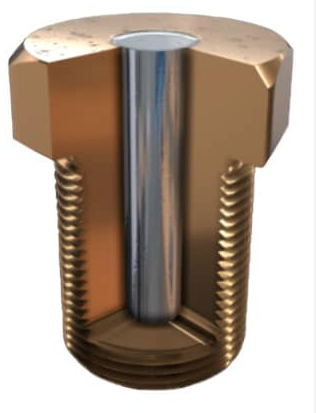Table of Contents
A Fusible Plug Preventing Explosion in Steam Boilers
A fusible plug is a safety device used in steam boilers to prevent boiler explosions caused by overheating. It is a simple but crucial component that helps protect the boiler and its surroundings from potential catastrophic failures.
Steam boiler play a vital role in various industries, powering engines and processes. However, without proper safety measures, they can pose significant risks. This article explores the importance of a fusible plug, a crucial safety component, in preventing explosions in steam boilers.

Understanding Steam Boilers
Steam boilers are ingenious devices that harness the power of steam to perform various tasks. These boilers use water as a primary medium, which is heated to produce steam. The steam generated holds immense energy, and when appropriately controlled, it can power engines, turbines, and heat processes. Steam boilers have become the backbone of industries worldwide, providing efficient and clean energy.
The Risk of Steam Boiler Explosions
Despite the benefits, Industrial steam boilers can be hazardous if not managed properly. One of the most significant risks associated with industrial steam boilers is the potential for explosions. Boiler explosions occur when pressure inside the boiler exceeds its design limits. The consequences can be catastrophic, leading to property damage, injuries, or even loss of life.
The Role of Fusible Plugs in industrial boiler
To mitigate the risk of boiler explosions, engineers and boiler manufacturers have developed various safety mechanisms. One of the most effective and time-tested safety features is the fusible plug. A fusible plug is a small, unobtrusive device installed in the steam boiler’s crown sheet – the top portion of the combustion chamber.
How Fusible Plugs Work in steam boilers
The fusible plug is made of a low-melting-point material, such as lead or tin, with a hollow center. In normal operating conditions, the steam boiler’s water level covers the plug, and steam surrounds it. However, in the event of low water levels due to operator negligence, the water level drops below the plug, leaving it exposed to the intense heat of the combustion chamber.
The Crucial Melting Process in Industrial Boiler
When the fusible plug is exposed to excessive heat, it reaches its melting point. As it melts, the hollow center allows steam to escape, acting as a safety valve. This controlled release of steam prevents pressure from building up to dangerous levels inside the boiler, effectively averting a potential explosion.
Importance of Regular Maintenance in Industrial Steam boilers
While fusible plugs are essential safety devices, they require regular maintenance and inspection to ensure their effectiveness. It is vital for Industrial boiler operators to conduct routine checks on the plugs, verifying their condition and integrity. Additionally, the water level in the boiler should be diligently monitored to avoid instances of low water levels, which could trigger the fusible plug to activate unnecessarily.
Industry Standards and Regulations
The use of fusible plugs in steam boilers is governed by industry standards and regulations to ensure utmost safety. Boiler manufacturers must adhere to strict guidelines in designing boilers that incorporate fusible plugs effectively. Furthermore, regular inspections and adherence to maintenance protocols are mandatory in many regions to minimize the risk of boiler explosions.
Common Causes of Boiler Explosions in industrial Steam Boilers
While fusible plugs play a crucial role in preventing boiler explosions, it is essential to address the root causes of such incidents. Some common causes of boiler explosions include:
1. Low Water Levels
As mentioned earlier, low water levels can expose the fusible plug to excessive heat, leading to its activation. Proper water level management is crucial to prevent this scenario.
2. Poor Maintenance
Neglecting routine maintenance can lead to the degradation of boiler components, including the fusible plug, reducing its effectiveness.
3. High Pressure
Operating the boiler at pressures beyond its design limits puts immense stress on all components, increasing the risk of catastrophic failure.
4. Overheating
Continuous operation at excessively high temperatures can weaken the structural integrity of the boiler, making it more susceptible to explosions.
Best Practices for Boiler Safety
To ensure maximum safety when operating steam boilers, it is essential to follow these best practices:
1. Regular Inspection and Maintenance
Conduct thorough inspections of the boiler and its safety components, including the fusible plug, at regular intervals. Address any issues promptly and perform necessary maintenance tasks.
2. Monitor Water Levels
Keep a close eye on the water level in the boiler to prevent low water situations that could activate the fusible plug. Implement automated water level control systems if possible.
3. Pressure Regulation
Operate the boiler within its recommended pressure limits and never exceed the manufacturer’s specifications.
4. Training and Education
Ensure that all boiler operators are well-trained and educated in boiler safety protocols and emergency procedures.
5. Compliance with Standards
Follow industry standards and regulations governing boiler operation, maintenance, and safety to maintain a safe working environment.
Fusible Plugs
Fusible plugs are an important safety device used in high-pressure systems. They are made of a metal alloy that melts at a specific temperature, and they are used to prevent catastrophic accidents by releasing pressure when the temperature gets too high.
How Fusible Plugs Work
Fusible plugs are installed in critical points in a high-pressure system where excess heat can accumulate. When the temperature reaches the melting point of the alloy, the plug melts and creates an opening for the pressurized medium to escape. This prevents the pressure from building up to dangerous levels, which could lead to an explosion.
Fusible Plugs in Steam Boilers
Fusible plugs are commonly used in steam boilers, where they play a vital role in ensuring safe operation. The plugs are typically located in the combustion chamber or firebox, where heat transfer occurs. If the temperature in the boiler gets too high, the plug will melt and release steam, preventing a potential explosion.

Fusible Plugs in Compressed Air Systems
Fusible plugs are also used in compressed air systems, where they can help to prevent catastrophic failures. Compressed air systems often operate under high pressures, and if there is a malfunction or overheating, the pressure can build up to dangerous levels. Fusible plugs can help to release excess pressure and prevent an explosion.
Regular Maintenance
It is important to regularly inspect and maintain fusible plugs to ensure that they are functioning properly. Periodic checks of the plugs’ condition, temperature ratings, and overall functionality are essential to guarantee their proper operation. Additionally, adherence to manufacturer guidelines and recommended service intervals is crucial for preserving the integrity of the plugs and the safety of the systems they protect.
Fusible plugs are an important safety device that can help to prevent catastrophic accidents in high-pressure systems. By understanding the purpose, functionality, and significance of fusible plugs, industries can enhance their safety protocols and ensure the smooth operation of their systems.
Here are some tips for using fusible plugs:
- Install fusible plugs in critical points in the system where excess heat can accumulate.
- Choose fusible plugs that are rated for the specific temperature and pressure of the system.
- Regularly inspect and maintain fusible plugs to ensure that they are functioning properly.
- Adhere to manufacturer guidelines and recommended service intervals for fusible plugs.
The fusible plug therefore melts by the heat of the furnace.Constructed of Bronze and Brass , the pipe plug has a tapered hole.
A Fusible Plug Preventing Explosion in Steam Boilers FAQ
A fusible plug in a boiler is a safety device designed to prevent catastrophic explosions by melting and releasing water, which helps to cool down the boiler when water levels drop dangerously low.
The fusible plug is installed in the crown sheet (top) of the Steam boiler’s firebox. It contains a core made of low-melting-point metal. When the water level drops below the plug, the heat from the fire causes the plug’s core to melt, creating an opening that allows water to flow onto the hot surfaces, preventing overheating and potential boiler failure.
The primary purpose of a fusible plug is to act as a last-resort safety measure in case of a sudden loss of water inside the boiler. It helps prevent boiler explosions and damage caused by excessive heat and pressure.
Regular inspection of the fusible plug is essential to ensure its effectiveness. It is recommended to inspect the plug during each boiler inspection or at least once every six months. If any signs of wear or damage are detected, the plug should be replaced immediately
No, once the fusible plug has melted, it loses its integrity and should be replaced with a new one. Reusing a melted plug could compromise boiler safety.
Fusible plugs are commonly used in fire-tube boilers, which have a large volume of water and a relatively small combustion chamber.
When the water level in the boiler drops below the plug, and the plug’s core melts, it creates an opening through which water rushes to contact the hot surfaces. This rapid cooling prevents the boiler’s metal from reaching critical temperatures and reduces the risk of a boiler explosion.
No, fusible plugs are just one of several safety devices used in boilers. Other safety features include pressure relief valves, low-water cutoff devices, and pressure gauges.
Although rare, a fusible plug could malfunction due to manufacturing defects or improper installation. Regular inspections and maintenance are crucial to ensure that the plug is functioning correctly.
It’s important to handle the fusible plug with care during inspection and replacement. Avoid damaging the plug or its surroundings, and always follow the manufacturer’s guidelines for maintenance procedures. Regular training of boiler operators on safety protocols is also essential.
Buy Boiler Spare Parts at the Best Price
Thermodyne Boilers supplies 100+ Industrial Boiler Parts all over India. Contact our sales team & send your requirement to get prices & discounts
